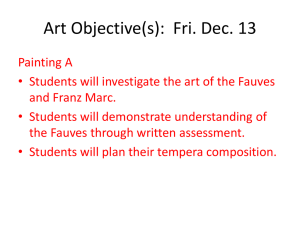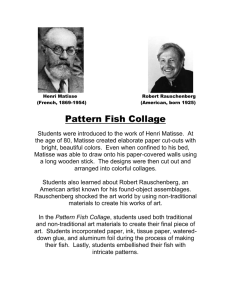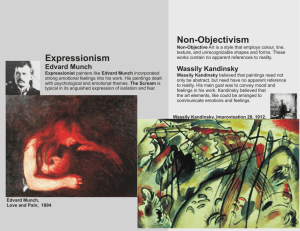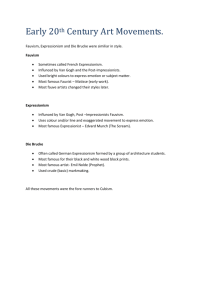Early Expressionism Symbolism Fauvism
advertisement
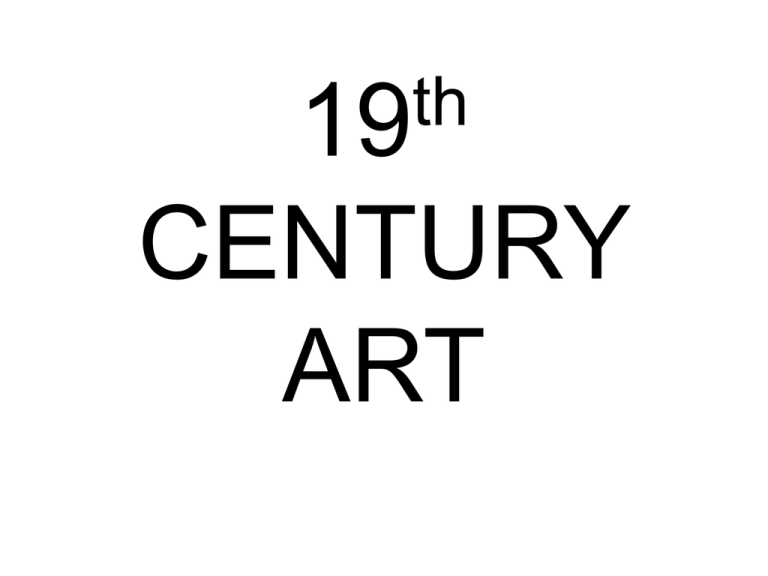
th 19 CENTURY ART Early Expressionism 1905 - 1925 • Expressionism was opposed to academic standards that had prevailed in Europe and emphasized the artist's subjective emotion, which overrides fidelity to the actual appearance of things. • The subjects of expressionist works were frequently distorted, or otherwise altered. • Landmarks of this movement were violent colours and exaggerated lines that helped contain intense emotional expression. Application of formal elements is vivid, jarring, violent, or dynamic. • Expressionists were trying to pinpoint the expression of inner experience rather than solely realistic portrayal, seeking to depict not objective reality but the subjective emotions and responses that objects and events arouse in them. • Many artists of this period assumed that the chief function of art was to express their intense feelings to the world. Edvard Munch (1863-1944) • Pronounced Moonk • Norwegian painter • An important inspiration for the German Expressionist movement • Spent time in Paris where he learned from Impressionist and PostImpressionist art • Most productive period was 1892- • Munch was a forerunner for Expressionism, a style that portrayed emotions through distorting form and colour • He produced paintings, etchings, lithographs, and woodcuts that expressed modern anguish with unequaled power • Munch was an outsider, brooding and melancholy, who called his painting his “children” • His mother and eldest sister died of comsumption when he was young, leaving him to be raised by a fanatically religious father Edvard Munch, Self Portrait with a Wine Bottle, 1906 • Even as an adult, Munch was so afraid of his father that he ordered “Puberty,” his first nude painting, to be covered at an exhibit that his father attended Edvard Munch, Puberty, Oil on canvas, 1894-95 • “Illness, madness, and death were the black angels that kept watch over my cradle,” Munch wrote of his painful youth • He was treated for depression at a sanatorium • He realized that his psychological problems were a catalyst for his art • He specialized in portraying extreme emotions like jealousy, sexual desire, and loneliness • He aimed to induce a strong reaction in his viewers • Although Munch often went for months without painting, once he began to work, he painted in a frenzy • Shows the fear of losing one’s mind • Every line heaves with agitation; there is no relief for the eye • Blood red clouds • When Munch first exhibited the painting, it caused such an uproar, the exhibit was closed Edvard Munch, The Scream, 1893 • After one bout of nonstop work, heavy drinking, and a disastrous love affair, Munch suffered a nervous break down. • Afterwards determined to put aside his tormented themes, his work became more optimistic but less moving Paula Modersohn-Becker (1876-1907) • An important precursor of Expressionism • German born • She worked in isolation, developing a completely modern style • Brief career, cut short by her death from childbirth • She concentrated on single figures: wideeyed, often nude, self-portraits and portraits of peasants Modersohn-Becker, Self-Portrait, 1906 Modersohn-Becker, Reclining Mother and Child, 1906 Symbolism • The forerunner of Surrealism • Artistic and literary movement that thrived in the last decade of the nineteenth century • Discarded the visible world of surface appearance for the inner world of fantasy Rousseau (1844-1910) • • • • French painter He was an untrained hobby painter Quit his job at age 40 to paint full time He believed that his fantastic, childlike landscapes - full of strange, lurking animals and tree sized flowers - were realistic paintings • His figures were flat and the scale, proportion, and perspective were skewed Rousseau, The Sleeping Gypsy, 1897 • Despite- or perhaps because of- these “flaws,” his stiff jungle scenes have an air of mystery and otherworldliness to them • He studied plants and animals at the Paris zoo, but his technical limitations were clear • He meticulously finished the painting’s surface so that no brushstrokes were visible Henri Rousseau, Eve, 1906-07 Odilon Redon (1840-1916) • Pronounced Ruh Don • Another French painter • The creatures of Redon’s imagination were even more bizarre than Rousseau • Create works that evoke a hallucinatory world • Radiant colour and line to inform his erotic, perverse visions • Influenced by the poetry of Poe and Baudelaire • Redon used iridescent colour to evoke a magical netherworld • Painting alludes to the mythological musician • Canvases sparkled with glowing colour • Disembodied head beside fragment of his lyre Redon, Orpheus, 1913 Twentieth Century • Styles quickly replacing one another • However, one theme was constant: art concerned itself less with exterior reality and more with interior vision • It declared all subjects fair game • It liberated form (as in Cubism) from traditional rules and freed colour (in Fauvism) from accurately representing an object • At the core of this philosophy of rejecting the past, called modernism, was a relentless quest for radical freedom of expression • No longer needing to please the patron, the artist stressed private concerns, experiences, and imagination as the sole source of art Fauvism 1904-1908 • Only a blip on the screen of world art • First avant-garde art movement of the twentieth century • Avant-garde: new and unusual or experimental ideas, especially in the arts, or the people introducing them. • Before the sky was blue and grass was green • But in canvases by Fauve artists, the sky was mustard-yellow , trees tomato-red, and faces pea-green • The publics response was hostile • The group got its name from a critic who called them “wild beasts” (fauves) • Others termed the work “raving madness,” “a universe of ugliness,” and “the naïve and brutal efforts of a child playing with its paintbox” • The Fauves’ radical departure from tradition originated when they saw retrospectives on van Gogh, Gauguin, and Cezanne from 1901-1906 • Another influence on the fauves’ refusal to imitate nature was their discovery on nonEuropean tribal arts Maurice de Vlaminck (1876-1958) • Did everything in extreme • When he ate lamb, he ate a whole leg; when he went cycling; he rode 150 miles in one day • Physically a big man who was extremely sure of himself • He taught boxing, played the violin in seedy cafes, and wrote soft-core porno novels • A self-taught artist • Overwhelmed by the 1901 van Gogh show, he started squeezing paint on the canvas straight from the tube, smearing bold colours thickly with a palette knife • He placed daubs of clashing colours side by side to intensify their effect Maurice de Vlaminck, The Orchard, 1905 Andre Derain (1880-1954) • Pronounced duh REN • Strong colour • Bold, directional brushstrokes eliminated lines and the distinction between light and shade • Later in life he turned to the Old Masters for inspiration and his work became dry and academic • In his harbor and beach scenes, the differing strokes- from choppy to flowing – give a sense of movement to sky and water Andre Derain, Boats in the Port of Collioure, 1905 Andre Derain, Big Ben, 1905 Georges Rouault (1871-1958) • Pronounced Roo OH • Worked with the Fauves briefly • Used expressive brushwork and glowing colour • Other Fauves painted urbane, joyous canvases, his were filled with pain and suffering • Devout Catholic • Lifelong concern was to redeem humanity through exposing evil • In his early work, he concentrated on condemning prostitutes and corrupt judges • Later he portrayed sad circus clowns • After 1918, virtually all his work was on religious subject • Aging Biblical king • Heavy, black lines compartmentalizing bodies into richly coloured segments in his mature oils have the feel of stained glass • Simplified bodies have a powerful, expressive function, to communicate his religious faith Rouault, The Old King, 1916-37 Henri Matisse (1869-1954) • The idea that art does not represent, but reconstructs, reality • “Colour was not given to us in order that we should imitate Nature,” he said, but “so that we can express our own emotions” • A minimalist before the term existed • Matisse sought to eliminate nonessentials and retain only a subject’s most fundamental qualities • He gained notoriety as leader of the Fauves’ 1905 show • Matisse lived in trying times (countless strikes, uprisings, assassinations, and two world wars) and yet his paintings ignored all social or political controversy • Matisse believed paintings should not only be beautiful but should bring pleasure to the viewer • Matisse came late to painting, having trained to be a lawyer to please his father Henri Matisse The Dance 1910 • Matisse perfectly evoked sensual nudes in line drawings with barely a dozen strokes • In his last years, Matisse was bedridden • He fastened a charcoal stick to a bamboo fishing pole and was able to sketch huge figures on the ceiling above his bed • His favourite activity was to cut fanciful shapes out of brightly coloured paper to be glued onto large-scale collages Henri Matisse, Les Betes de la Mer, 1950 • Used colour to transform a conventional subject into a vibrating, original design • The unexpected streak allows the head to compete with the assertive background • Stressed surface pattern, placing equal emphasis on foreground and background Henri Matisse, The Green Stripe, 1905 Sculpture Constantin Brancusi (1876-1957) • Rumanian artist • Shaved away detail almost to the vanishing point • Saw reality in terms of a few basic, universal shapes: the egg, the smooth pebble, and the blade of grass • Whatever the subject, he simplified its form • Left home at age 11 to work as a shepherd and wood-carver • He then made his way from Bucharest to Paris on foot • Offered a job as assistant to Rodin • Brancusi refused, saying, “No other tree can grow in the shadow of an oak” • Represents not an actual bird but the concept of flight • When “Bird in Space” was brought to the U.S. for a Brancusi show, a custom inspector refused to exempt it from duty as a sculpture • He instisted that in no way did it resemble a bird, therefore, not a work of art but a hunk of metal to be taxed as raw material Brancusi, Bird in Space, 1927 Amadeo Modigliani (1884-1920) • Known primarily for paintings of reclining nudes • Was brash in both sculpture and zest for life • Too handsome for his own good, Modi (as he was called) plunged into the bohemian life in Paris • Poor as a pauper, he dressed to the hilt, with flying red scarf and loud corduroy suit • When the mood struck, he was wont to strip off his clothes, shouting to astounded café patrons, “Look at me! Don’t I look like a god?” • Spent the night in bars, chanting poetry, swilling down cheap wine and absinthe, and smoking hashish • He treated his mistress horribly • Once, in a violent rage, he threw her out the window • “People like us have different rights from other people because we have different needs which put us … above their morality,” he wrote • Modi painted portraits for a few francs to buy drink, but poverty was a real handicap when it came to sculpture • For wood to carve he stole railway ties • Modi carved simplified figures that radiate Primeval power • After drinking all night and selling the suit he was wearing to buy more wine, he caught pneumonia in the bitter cold of dawn. • Died at the age of 35 • Figures have long, thin necks, sloping shoulders, tilted heads with small mouths, long noses, and blank slits for eyes Amadeo Modigliani, Nu couche de dos (Reclining Nude from the back),1917 Amadeo Modigliani Nude Sdraiato Amedeo Modigliani, Tete, 1911-12 Fin

